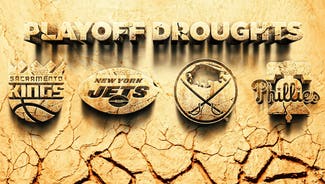
NHL lockout: What you need to know
The word ''lockout'' is here again for another major pro sport, this time the National Hockey League. In question-and-answer form, this is a look at the issues and implications of the work stoppage in the NHL.
----
Q: WHY IS THE NHL HAVING LABOR ISSUES?
A: At its core, this is a dispute over money.
The league's labor contract, agreed to seven years ago, expired on Sept. 15. Having gained a salary cap in the previous collective bargaining agreement, NHL owners want additional economic concessions from players.
----
Q: WHY DO OWNERS NEED A BETTER DEAL?
A: NHL Commissioner Gary Bettman says ''in these economic times there is a need to retrench.'' He says the last deal the players got was fair. In fact, from the owners' perspective, it was more than fair, especially considering all of the NHL's expenses are covered by the league, not the players.
----
Q: AND HOW HAVE PLAYERS RESPONDED?
A: Citing that annual industry revenue has grown from $2.1 billion to $3.3 billion under the recently expired deal, players say they shouldn't be forced to make concessions. Players are also very concerned about receiving the entire amount of money on the salaries they signed before the lockout.
----
Q: IT SEEMS AS IF LABOR STRIFE IS COMMON TO THE NHL. IS THAT TRUE?
A: It has been during the past two decades. Players struck in 1992, a walkout settled on the 11th day after 30 games were postponed. A 103-day lockout in 1994-95 led to the cancellation of 468 games, reducing each team's schedule from 82 games to 48. Another lockout eliminated the 2004-05 season, making the NHL the first major pro sports league in North America to lose an entire season to a labor dispute. It was settled on the 301st day, July 13, 2005, after players agreed to a salary cap.
----
Q: HAVE OTHER LEAGUES HAD WORK STOPPAGES RECENTLY?
A: Yes. The NHL work stoppage is the third lockout in an 18-month span, following the NFL (March 11 to Aug. 5 last year) and the NBA (July 1 to Nov. 26 last year). While no NFL regular-season games were canceled, the NBA cut each team's schedule from 82 to 66 games.
----
Q: WHICH OF THE U.S. MAJOR LEAGUES HAS HAD THE MOST LABOR TURMOIL?
A: Major League Baseball still leads with eight work stoppages (five strikes and three lockouts), the last a 7 1/2-month strike that led to the cancellation of the 1994 World Series. The NFL has had five stoppages (four strikes and one lockout) and the NBA four (all lockouts).
----
Q: SO WHY HAS BASEBALL BEEN FREE FROM LABOR STRIFE OF LATE?
A: It's likely not a coincidence that the three major U.S. leagues with salary caps all have had turmoil. Since the 1994-95 strike, baseball players and owners have concluded agreements without stoppages in 2002, 2006 and last year, finding that they can make concessions in certain areas in exchange for gains in others. The sports with the cap systems appear somewhat more restricted, with less areas of back-and-forth since the basic structure is in place.
----
Q: WAS THE NHL HURT BY THE LAST LOCKOUT?
A: Attendance did not suffer at all, lending credence to the notion that hockey has a committed fan base that will retain its season tickets. The league's regular-season average increased from 16,534 in 2003-04 to 16,954 in 2005-06, according to STATS LLC, and was 17,454 last season. Only seven teams experienced substantial decreases from 2003-04 to 2005-06: Columbus (17,369 to 16,796), Dallas (18,355 to 17,829), Edmonton (17,678 to 16,833), New Jersey (15,060 to 14,230), the New York Islanders (13,456 to 12,609), St. Louis (18,560 to 14,213) and Washington (14,720 to 13,905). In contrast, Major League Baseball has larger venues and nearly twice as many games and is far more reliant on single-game sales. After the 1994-95 strike, MLB's average attendance didn't recover to its pre-walkout level until 2007.
----
Q: HOW ABOUT THE NHL'S WIDER AUDIENCE, AS MEASURED BY TELEVISION RATINGS?
A: Tampa Bay's win over Calgary in the 2004 Stanley Cup finals averaged 3.3 million viewers on ABC and ESPN, according to Nielsen Media Research, while Carolina's victory over Edmonton in 2006 averaged 2.8 million on NBC and OLN. Average viewers rose to 5.2 million on NBC and Versus when Chicago beat Philadelphia in 2010, then fell to 4.6 million on the same networks for Boston's victory over Vancouver in 2011 and 3 million on NBC and the NBC Sports Network for Los Angeles' win over New Jersey this year. Just for comparison with other leagues, last February's Super Bowl was seen by 111 million people and the World Series and NBA Finals each averaged more than 16 million viewers.
----
Q: HOW LONG WILL THE LOCKOUT LAST?
A: There's no telling. The recent proposal by the league and the owners seems to be a good starting point for both sides. The Winter Classic between the Detroit Red Wings and Toronto Maple Leafs is scheduled for Michigan Stadium in Ann Arbor on Jan. 1, and the All-Star game is slated for Columbus, Ohio, on Jan. 27. Last season's Winter Classic, a 3-2 win by the New York Rangers over Philadelphia at Citizens Bank Park, averaged 3.74 million viewers on NBC and was the fifth-most watched regular-season NHL game in 37 years. This year's All-Star game was seen by 1.3 million on NBC Sports Network.


